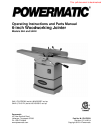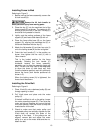
9
Assembly
Unpacking and Cleanup
Locate the jointer in an area that is level and
provides a solid foundation. Make sure that any
potential kickback is not in line with aisles,
doorways, wash stations or other work areas.
1. Carefully finish removing all contents from both
shipping cartons. Compare contents of the
shipping cartons with the list of contents on
page 8. Place parts on a protected surface.
2. Set packing material and shipping cartons to
the side. Do not discard until machine has
been set up and is running properly.
Cutterhead knives are
dangerously sharp; use
extreme caution when cleaning. Failure to
comply may cause serious injury!
3. Moisten a soft cloth with kerosene and remove
the protective coating from all machined
surfaces of the jointer. Do NOT use an
abrasive pad. Do not use gasoline, acetone or
lacquer thinner, as these may damage painted
surfaces.
4. Apply a thin layer of paste wax to the exposed
surfaces of the fence and tables to prevent
rust. Alternatively, white talcum powder rubbed
in vigorously once a week with a blackboard
eraser will fill any casting pores and form a
moisture barrier. Talcum powder will not stain
wood or mar finishes.
Installing Bed to Stand
1. Position the jointer on the stand so that the
pulley attached to the cutterhead on the jointer
is directly above and on the same side as the
motor pulley.
2. Use three lock bolts and spring washers
(Figure 3) to firmly fasten the jointer to the
stand. The bolts are threaded up through the
holes in the stand into the base of the jointer
(Figure 4).
3. Use a 14mm wrench to tighten the lock bolts.
Figure 3
Figure 4


















